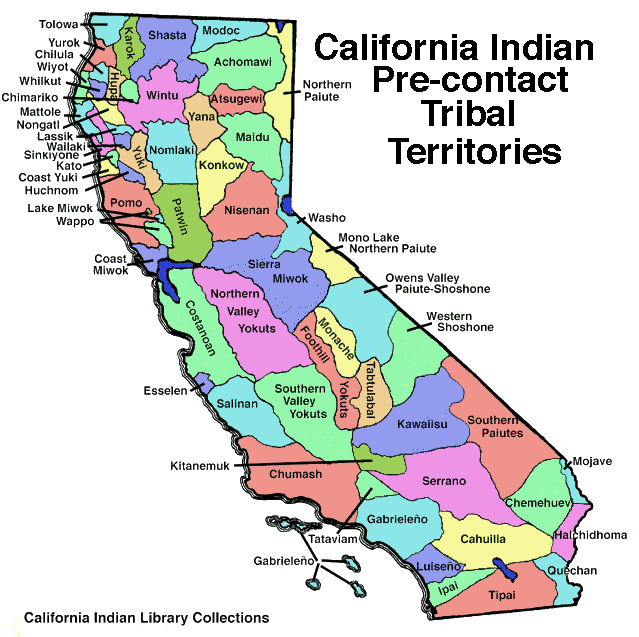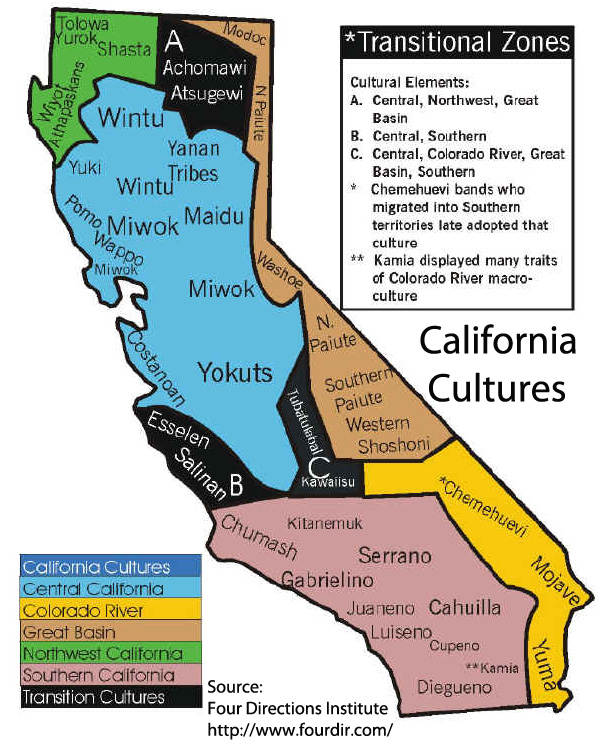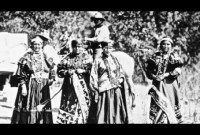
A Kaleidoscope of Cultures: Unearthing the Diverse Native American Tribes of California
Beneath the glittering veneer of California’s modern marvels lies a history far older, richer, and more diverse than many realize. Long before the Spanish missions, the Gold Rush, or the Silicon Valley boom, this vast and varied land was home to an extraordinary mosaic of Indigenous peoples. Far from being a monolithic entity, Native California was a vibrant tapestry of hundreds of distinct tribal nations, speaking over 100 mutually unintelligible languages and dialects, making it one of the most culturally and linguistically diverse regions in North America.
This immense diversity was a direct reflection of California’s unique geography – a land encompassing towering redwood forests, snow-capped mountains, fertile valleys, sprawling deserts, and an expansive coastline. Each tribal group adapted ingeniously to its specific environment, developing unique economies, social structures, spiritual practices, and artistic traditions that allowed them to thrive for millennia.

The Northwest: Giants of the Redwoods and Rivers
In the misty, ancient redwood forests and along the powerful rivers of Northern California, lived tribes such as the Yurok, Hupa, and Karuk. These nations shared a deep reverence for the land and its most vital resource: salmon. The annual salmon runs were not just a food source but the bedrock of their economy, spiritual life, and social hierarchy. Their plank houses, built from split redwood, were often large and meticulously crafted, reflecting a culture of considerable wealth derived from the abundance of the natural world.
The Yurok, in particular, lived along the Klamath River and the Pacific coast, their spiritual beliefs intricately tied to the river and its creatures. They developed a sophisticated legal system and a unique form of currency based on dentalium shells. Their spiritual world was rich, with elaborate ceremonies like the White Deerskin Dance and the Jump Dance, performed to renew the world and ensure its continued balance. As one Yurok elder might say, "The river is our lifeblood; it carries our stories, our food, our very existence."
The Central Valley and Sierra Nevada: Acorns, Abundance, and Artistic Mastery
Moving inland to the vast, fertile Central Valley and the foothills of the Sierra Nevada, lived large, settled populations such as the Miwok, Yokuts, and Maidu. For these tribes, the mighty oak tree was the primary source of sustenance. Acorns, painstakingly gathered, processed to remove tannins, and then ground into flour, formed the staple of their diet. This highly nutritious food allowed for the development of large, stable villages and complex social structures.
The Miwok, spread across the Sierra foothills and parts of the Central Valley, were renowned for their intricate basketry, as were many California tribes. These baskets were not merely functional; they were exquisite works of art, often woven with such tight precision that they could hold water. Their oral traditions speak of a deep connection to the animal world, with many creation stories featuring Coyote as a central figure. The Yokuts, inhabiting the southern Central Valley, built large dome-shaped houses from tule reeds and engaged in extensive trade networks, exchanging goods from the coast with those from the mountains.
The Coastal Regions: Masters of the Maritime Realm
Along California’s long and varied coastline, different groups adapted to the bounty of the ocean. In the south, the Chumash of the Santa Barbara Channel and islands were legendary mariners. They constructed remarkable plank canoes called tomols, sewn together with plant fibers and caulked with natural asphaltum. These sophisticated vessels allowed them to travel far offshore, fish in deep waters, and maintain extensive trade routes with the Channel Islands and mainland communities. Their rock art, found in caves throughout their territory, depicts a rich spiritual world, often with astronomical themes.

Further north, around the San Francisco Bay Area, lived the various bands of the Ohlone people (a collective term for many distinct linguistic groups). They harvested shellfish, hunted sea mammals, and gathered a wide array of plants, including acorns. Their shell mounds, accumulated over thousands of years, stand as testament to their long occupation and sustainable harvesting practices. Along the North Central Coast, the Pomo people were celebrated for their unparalleled basketry, often incorporating feathers and beads, making them some of the most intricate and beautiful in the world. A Pomo proverb speaks to their artistry: "Our baskets are our homes, our food, our spirit."
The Deserts and Arid Lands: Resilience in Harsh Environments
Eastern and Southern California’s arid regions were home to tribes like the Cahuilla, Kumeyaay, Serrano, and Mojave in the south, and the Paiute and Shoshone in the Great Basin-influenced eastern territories. These groups demonstrated incredible ingenuity in adapting to seemingly harsh environments. They developed profound knowledge of scarce water sources, edible desert plants, and the movements of desert game.
The Cahuilla, inhabiting the Coachella Valley and surrounding mountains, were masters of desert survival, utilizing mesquite beans, agave, and various cacti. They lived in small, mobile groups, following seasonal resources, and maintained complex kinship systems. The Kumeyaay, straddling the modern U.S.-Mexico border, utilized both coastal and desert resources, moving between the mountains, deserts, and the Pacific depending on the season. Their extensive knowledge of trade routes connected them to tribes far beyond their immediate territory.
Threads of Unity: Shared Values and Enduring Legacies
Despite their immense diversity, many California Native American tribes shared fundamental characteristics. A deep spiritual connection to the land and all living things was paramount. The concept of "taking only what you need" and "stewardship" was ingrained, leading to highly sustainable resource management practices, including controlled burns to promote plant growth and manage forests. Oral traditions were the primary means of transmitting history, law, spiritual beliefs, and practical knowledge across generations, often through captivating stories, songs, and ceremonies. Trade networks, facilitating the exchange of goods like obsidian, shells, and food, crisscrossed the state, fostering intertribal relationships.
The Unraveling and the Re-weaving: Impact and Resilience
The arrival of Europeans brought catastrophic changes. The Spanish Mission system, beginning in 1769, forcibly removed Native peoples from their ancestral lands, suppressed their languages and cultures, and exposed them to devastating diseases. This was followed by the Mexican period and, most devastatingly, the American Gold Rush and subsequent statehood. The Gold Rush triggered an influx of non-Native settlers, leading to widespread violence, land dispossession, and genocidal policies enacted by the state and federal governments. Estimates suggest the Native population of California plummeted from around 300,000 in 1769 to a mere 30,000 by 1870.
Yet, the spirit of these nations was not extinguished. Against immense odds, many survived. Today, California has the largest Native American population of any U.S. state, with over 100 federally recognized tribes and many more seeking recognition. There is a powerful and ongoing movement of cultural revitalization: languages are being taught again, traditional ceremonies are being revived, and tribes are asserting their sovereignty and engaging in economic development to benefit their communities. The "Land Back" movement, advocating for the return of ancestral lands, is gaining momentum, symbolizing a deep desire to heal historical wounds and reclaim rightful stewardship.
Conclusion: California’s Enduring Indigenous Heart
To truly understand California is to acknowledge and celebrate its Indigenous roots. The names of its cities, rivers, and mountains often echo the languages of its first peoples – Cahuilla, Yosemite, Malibu, Napa. The vibrant basketry, the resilient spirit, and the profound wisdom of sustainable living that characterized these diverse tribes continue to resonate.
The stories of the Yurok, Chumash, Ohlone, Miwok, Cahuilla, and hundreds of others are not relics of the past; they are living narratives of adaptation, survival, and enduring cultural strength. By learning about the tribes who lived in California, we not only pay respect to their legacy but also gain a deeper appreciation for the rich human tapestry that shaped, and continues to shape, this remarkable land. Their presence reminds us that beneath the surface of modern progress lies an ancient, intricate world, waiting to be rediscovered and honored.


